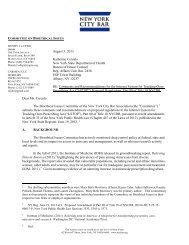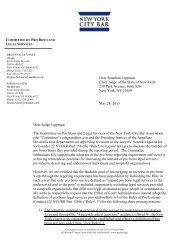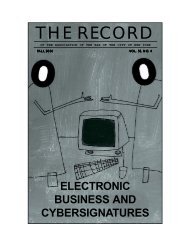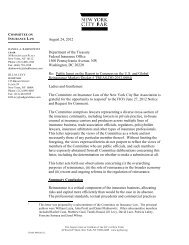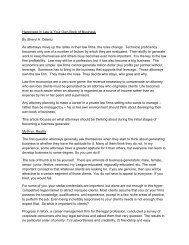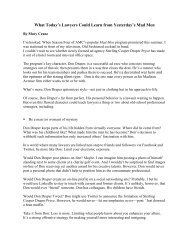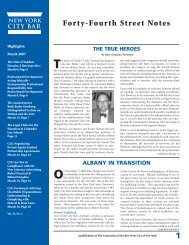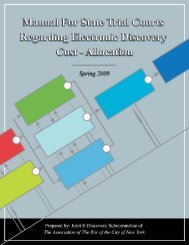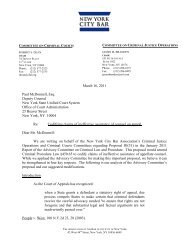2007 Issue 1 - New York City Bar Association
2007 Issue 1 - New York City Bar Association
2007 Issue 1 - New York City Bar Association
Create successful ePaper yourself
Turn your PDF publications into a flip-book with our unique Google optimized e-Paper software.
F O R M A L O P I N I O N 2 0 0 7 - 2<br />
to the law firm, or that the seconded lawyer would remain associated<br />
with the firm. First, the law firm has been representing the host organization<br />
all along in the matter, so the law firm continuing to work on the<br />
matter does not by itself create any additional conflict. Second, there is<br />
little difference between the law firm continuing to supervise the seconded<br />
lawyer in this circumstance, and the host organization engaging the law<br />
firm to complete that representation and to work with the seconded lawyer<br />
as a representative of the host organization. To conclude either that<br />
additional conflicts would be imputed or that the seconded lawyer would<br />
remain associated with the law firm would elevate form over substance<br />
and create an unjustifiable rift between the host organization on the one<br />
hand and the seconded lawyer and the law firm on the other, undermining<br />
the host organization’s right to the counsel of its choice. Levine v.<br />
Levine, 56 N.Y.2d 42, 451 N.Y.S.2d (1982) (recognizing, in the context of<br />
law-firm conflicts, that the right to counsel is a fundamental right).<br />
But these considerations are entitled to less weight if the law firm<br />
supervises the seconded lawyer in connection with one or more new representations<br />
of the host organization. Moreover, even one significant new<br />
representation in which the law firm supervises the seconded lawyer could<br />
result in the sort of close and regular relationship between the seconded<br />
lawyer and the law firm that would likely result in conflicts being imputed<br />
and the lawyer being considered associated with the firm. Hempstead<br />
Video, Inc., supra.<br />
Finally, if the law firm supervises the seconded lawyer in connection<br />
with the seconded lawyer’s representing other clients of the law firm, this<br />
would be a partial secondment, and, as discussed above, conflicts would<br />
be imputed to the law firm.<br />
IV. The Effect of Different Compensation Arrangements<br />
on the Determination of <strong>Association</strong> and the Imputation of Conflicts<br />
We next consider whether, if the firm continues to pay the seconded<br />
lawyer during the secondment, or if the host organization pays the firm<br />
for the secondment, the seconded lawyer remains associated with the firm,<br />
or conflicts are otherwise imputed to the firm. If the law firm pays the<br />
seconded lawyer during the secondment, this alone does not result in the<br />
imputation of conflicts to the firm, or make the lawyer associated with<br />
the firm, so long as the seconded lawyer’s professional judgment is not<br />
directed by the firm and the lawyer lacks access to the confidences and<br />
secrets of the firm’s clients. Cf. DR 5-107(B) (with the consent of the client,<br />
a lawyer may accept compensation for legal services from one other<br />
2 0 0 7 V O L. 6 2 , N O. 1<br />
161



